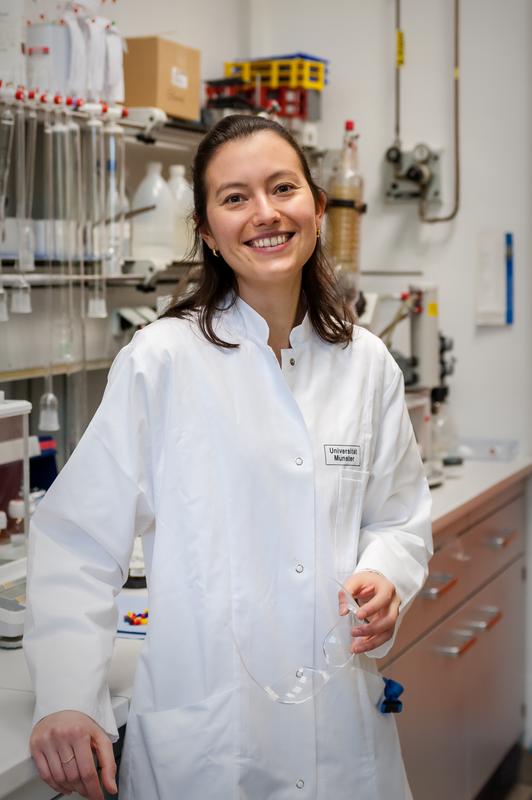Two chiral catalysts working hand in hand: Chemists develop a new synthetic method

Dr. Eloisa Serrano, one of the two lead authors WWU - Peter Dziemba
Just as our left hand is not superposable to our right hand, the mirror image of certain molecules cannot be overlapped onto it, even when turned or twisted. These two mirror images are referred to by chemists as enantiomers and the molecule is said to be chiral.
Chirality, which is a word derived from the ancient Greek word for hand, is important since it is present in our daily lives. For example, the stereoisomers of a molecule – i.e. compounds in which the binding pattern is the same but which differ in the spatial arrangement of the atoms – can produce different effects when interacting with a biological system.
The stereoisomers of a drug, for example, can have different or even opposite effects on the body making it crucial to produce certain stereoisomers of a pharmaceutical compound. A central task for chemists is to develop methods that are switchable and can selectively produce one or another stereoisomer, from simple and identical starting materials using tunable reaction conditions.
A team of researchers led by Prof. Frank Glorius from the University of Münster (Germany) has developed a new synthetic method for the targeted synthesis of all four stereoisomers of so-called α,β-disubstituted γ-butyrolactones.
γ-Butyrolactones are widespread motifs in natural products that display a wide range of biological activities. One important example is pilocarpine, a drug used to treat glaucoma. The newly developed synthetic method is based on the combination of two chiral catalysts—an organocatalyst and a metal catalyst—which each independently activate one of the two reaction partners.
“I very much like the picture of these two catalysts working hand in hand together,” Frank Glorius states. The catalysts are not consumed or changed during the course of the reaction, and work in sync to efficiently produce the final product, which contains two stereocenters. As each stereocenter can have two potential orientations – up or down – four possible products could be generated in this case.
The chemists use the different combinations of the two chiral catalysts to control the formation of only one of the four possible products, but are able to access any of the products. This is a quite rare feature that only few chemical processes exhibit.
“Our method streamlines the synthesis of chiral α,β-disubstituted γ-butyrolactones into a single step, starting from simple precursors and using two chiral catalysts. It is a system that basically lets you chose which stereoisomer you want to make,” says Dr. Santanu Singha, one of the lead authors.
“It is amazing, the enantioselectivity is perfect, better than 99 percent, in nearly all of the cases,” continues Dr. Eloisa Serrano, another lead author. Since the γ-butyrolactone products are in the core of multiple natural products with interesting biological activities, the authors expect their method to be of high relevance in drug discovery. The results of the researchers’ work have been published in the latest issue of the journal “Nature Catalysis”.
Funding:
The study received financial support from the German Research Foundation (Leibniz Prize) and the European Union (Marie Skłodowska Curie grant).
Prof. Frank Glorius (Münster University)
Phone: +49 251 8333248
glorius@uni-muenster.de
S. Singha & E. Serrano et al. (2019): Diastereodivergent synthesis of enantioenriched α,β-disubstituted γ-butyrolactones via cooperative N-heterocyclic carbene and Ir catalysis. Nature Catalysis; DOI: 10.1038/ s41929-019-0387-3
https://www.nature.com/articles/s41929-019-0387-3#article-info Original publication in “Nature Catalysis”
https://www.uni-muenster.de/Chemie.oc/glorius/index.html Glorius Group at Münster University
Media Contact
All latest news from the category: Life Sciences and Chemistry
Articles and reports from the Life Sciences and chemistry area deal with applied and basic research into modern biology, chemistry and human medicine.
Valuable information can be found on a range of life sciences fields including bacteriology, biochemistry, bionics, bioinformatics, biophysics, biotechnology, genetics, geobotany, human biology, marine biology, microbiology, molecular biology, cellular biology, zoology, bioinorganic chemistry, microchemistry and environmental chemistry.
Newest articles

Bringing bio-inspired robots to life
Nebraska researcher Eric Markvicka gets NSF CAREER Award to pursue manufacture of novel materials for soft robotics and stretchable electronics. Engineers are increasingly eager to develop robots that mimic the…

Bella moths use poison to attract mates
Scientists are closer to finding out how. Pyrrolizidine alkaloids are as bitter and toxic as they are hard to pronounce. They’re produced by several different types of plants and are…

AI tool creates ‘synthetic’ images of cells
…for enhanced microscopy analysis. Observing individual cells through microscopes can reveal a range of important cell biological phenomena that frequently play a role in human diseases, but the process of…





















